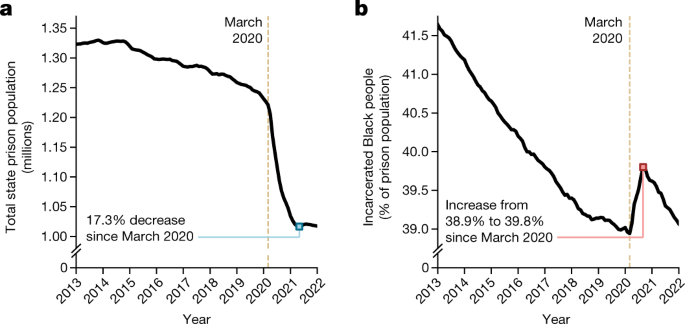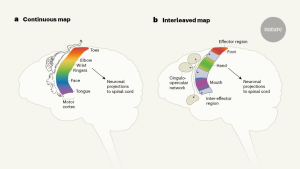
The race in prisons of the US deepened during COVID
How change in prison releases affected the COVID-19 prison system during the pandemic compared to the pre-Pandemic average
Estimates of change in monthly releases are calculated as a percentage of pre-pandemic values. Despite efforts to reduce prison density through targeted releases, the rate of prisoner release was lower during much of the epidemic. At its lowest value (between February and May 2021), the number of people released from prison each month reached nearly 70% of pre-pandemic values. In the absence of changing admission patterns, this decline in releases should have led to an increase in the total incarcerated population in the USA, which is the opposite of the pattern we see in Fig. 1a. Therefore, we can conclude rather strongly that changing release rates did not drive the reduction in the incarcerated population during the pandemic. Black people had a higher percentage of monthly releases during the early months of the COVID-19 Pandemic compared to the pre-Pandemic average. As was the case for demographics of prison admissions, disparities in the monthly releases are unlikely to be driving the trends in Fig. 1b. In the next section, we focus less on those released from prison in a single month, and more on people who are still in prison.
To explain the reversal, the researchers examined racial differences in admissions, releases and sentencing. The trend is not explained by admissions or releases alone.
“Black people are, on average, serving sentences that are 20% longer than white people,” says Brennan Klein, a network scientist at Northeastern University in Boston, Massachusetts, and a co-author of the study.
“We can look at the way that we sentence people, who we sentence and how long we sentence people. And that alone will help us reduce these really alarming disparities in our prison system,” says Elizabeth Hinton, a historian at Yale University in New Haven, Connecticut, and a co-author of the study.
Nicole Gonazalez VanCleve says the results could affect how policymakers focus on reducing racial inequalities in the system.
She says the focus is often on decriminalising certain behaviours to avoid disproportionately incarcerating certain racial groups and using releases as an escape valve. “I think what makes this paper really powerful is that we can see that, despite looking at the admissions and the releases, the sentencing still had this enormous, enduring effect of racism.”
The study authors said that there were lessons to learn from the different ways that criminal systems use to track race in the United States, and the barriers that they faced to gather and standardize the data.
Consider a time series of a state’s prison population that does not notably change over several years. For this to occur, there needs to be approximately the same number of admissions and releases. For the demographic makeup of the prison population to remain stable, the relative number of admissions and releases by race also needs to be roughly equivalent over time. If there are sustained periods with more admissions (or releases) of a certain demographic, that will skew the overall distribution of the prison population.
Several states enacted policies to de-bunk prisons in an effort to reduce the risk of severe acute respiratory syndrome coronavirus 2 transmission. The directives came from executive orders from governors, state legislatures and governing boards. In Utah, for example, policies around releases are designed, approved and implemented by the Board of Pardons and Parole—an entirely separate entity from the courts and the Department of Corrections. According to the Board of Pardons and Parole, incarcerated people who are eligible for early release needed to be already characterized as a non-violent offender, be within 90 days of release (this was later extended to 180 days26) and have an approved address to stay at after their release.

